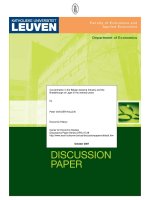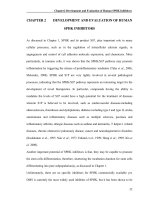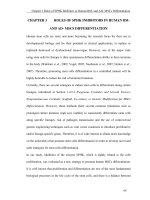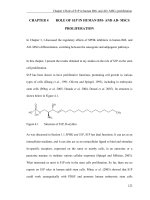Overtrawlability and mechanical damage of pipe in pipe
Bạn đang xem bản rút gọn của tài liệu. Xem và tải ngay bản đầy đủ của tài liệu tại đây (19.79 MB, 356 trang )
OVERTRAWLABILITY AND MECHANICAL
DAMAGE OF PIPE-IN-PIPE
Zheng Jiexin
(B. Eng., M. Eng.)
A THESIS SUBMITTED
FOR THE DEGREE OF DOCTOR OF PHILOSOPHY
DEPARTMENT OF CIVIL AND ENVIRONMENTAL ENGINEERING
NATIONAL UNIVERSITY OF SINGAPORE
2014
i
Acknowledgment
First of all, I would like to express my deepest appreciation to my supervisor
Professor Andrew Palmer, who is an admirable pioneer in the subsea pipeline
area. Without him, my PhD study in NUS would not have been possible. I am
grateful for his support, his patience, his motivation, his enthusiasm, and
immense knowledge; all of them play an important part in the success of this
PhD program. He encourages me, supports my choices, offers me
opportunities and builds up my confidence. Without his guidance throughout
these four years, my PhD study would not have been so worthwhile and
fruitful. The way he treats research, as well as other aspects will definitely
leave a long term impact on my future.
I would also like to convey my heartfelt thanks to Prof. Stelios Kyriakides at
University of Texas at Austin for his guidance and help in simulating the
external pressure using hydrostatic fluid elements as well as his inspirational
ideas. He is a great professor, for whom I have utmost respect.
I also would like to thank Prof. Qian Xudong for taking time to discuss finite
element models and the results with me, and his suggestions of ways to
improve them. I would like to thank my colleague Sun Shu, the research
assistant for this project, for her help in measuring the deformed profile of the
pipes after the experiments and helping me with the pull-over model tests. The
preparation of the pull-over model tests was not easy. She helped me in
correspondence with contractors, purchasing of pipes and sensors, preparing
ii
drawings, and offering her valuable ideas in the design. After she has finished
her master and began work in her current company, the contractors Martin
Loh, Tay Poh Chuan and Khoo Ah Muan continued to help me with the
laborious works. Poh Chuan is very helpful: carrying pipe and trawl gear,
handling of the boat and so on. He joked that he should be a co-author of the
thesis. I never expected I could do 100 tests, but we did it. I also want to thank
Wang Yu, Kazi Md. Abu Sohel for their generous sharing. Moreover, I want
to thank Ee Weng for his generous help with the impact tests.
I would also like to thank the laboratory staffs, Mr. Ang Beng Oon, Mr. Koh
Yian Kheng, Mr. Ishak Bin A Rahman, Mr. Lim Huay Bak, Mr. Yip Richard,
Mr. Choo Peng Kin, Mr. Kamsan Bin Rasman, Mr. Ow Weng Moon, Mr.
Shaja Khan, Mr. Krishna Sanmugam, Mr. Semawi Bin Sadi and Mr. Koh Seng
Chee. Without their assistance, the laboratory would not have been functional
and my extensive experiments would not have been finished.
I am indebted to SUBSEA 7 for the financial and technical supports for this
research. Particular thanks to Paul Brunning, who continually renders me help
on this project for three years and the other project managers Wacek Lipski,
Gan Cheng Ti, and Gerry Lim.
Special thanks to Simon Falser, Hendrik Tjiawi, Matilda Loh, Xie Peng and
Too Jun Lin. The Oppenheim meeting with them every week gave me
motivation and pressure to finish my plan and achieve more. I also want to
thank my friends, my lunch partners and my colleagues on the 8th floor of
Block E1, in the structural lab and in the hydraulic lab. Without their
iii
company, the life in school and the lunches in the canteen would be much less
joyful.
Last but not least, I would like to give thanks to my family and my husband
Yap Kim Thow for their unwavering support and understanding. Their
unconditional love gives me warmth and the strength to carry on.
Financial supports in the form of the NUS Research Scholarship and the
President Graduate Fellowship for my Ph.D. candidature are gratefully
acknowledged.
iv
v
Contents
Acknowledgment i
Contents v
Summary ix
List of tables xi
List of figures xiii
List of Symbols xxiii
Abbreviations xxiii
Symbols xxiii
1 Introduction 1
1.1 Background 1
1.2 Motivation 2
1.3 Objective and Scope 3
1.3.1 Objective of Research 3
1.3.2 Scope of Research 5
1.4 Layout of Current Thesis 5
2 Literature Review on Overtrawlability of Subsea Pipelines 7
2.1 Trawl Gear 7
2.2 Impact Response 11
2.3 Dent Behaviour 30
2.3.1 Stress concentration 31
2.3.2 Burst pressure 33
2.3.3 Fatigue 34
2.3.4 Summary of dent behaviour 35
2.4 Pull-over Response 36
2.5 Pull-over Induced Lateral Buckling 45
2.6 Hooking 46
2.7 Existing Guidelines 47
vi
2.7.1 Guidelines for Trenching Design of Submarine Pipelines (Trevor
Jee Associates, 1999) 47
2.7.2 DNV-RP-F111: Interference between Trawl Gear and Pipelines
(2010) 51
2.7.3 NORSOK Standard U-001(2002) 57
2.8 Pipe-in-Pipe system and Overtrawlability 58
3 Quasi-static Indentation Test Program 61
3.1 Test Specimen Preparation 61
3.2 Indenter Design 65
3.3 Quasi-static Indentation Test Set-ups 68
3.4 Instrumentations 71
3.5 Quasi-static Indentation Test 74
3.6 Test Results of Quasi-static Indentation Test 75
3.6.1 Single Wall Pipe Indentation Test Results 75
3.6.2 Pipe-in-pipe Indentation Test Results 77
3.7 Discussion of Test Results 79
3.8 Model Test Data Scale Up 85
3.9 Summary 86
4 Impact Test Program 89
4.1 Impact Test Design 89
4.2 Test Results of Impact Experiments 96
4.3 Discussion 104
4.3.1 Model Test Scaling Laws of Impact 104
4.3.2 Impact Energy 107
4.4 Summary 108
5 Finite Element Modelling and Further Analysis 111
5.1 Single Wall Pipe Quasi-static Indentation Model 111
5.2 Pipe-in-Pipe Quasi-static Indentation Model 122
5.3 Summary of the Finite Element Model of Quasi-static Indentation 132
5.4 Impact FE Models 132
5.5 Quasi-static Indentation & Dynamic Impact 143
5.5.1 Quasi-static Response & Impact Response 144
5.5.2 Strain Rate Effect 145
5.6 Prototype Comparisons 150
5.6.1 Impact Energy 150
vii
5.6.2 PIP12 & PIP14 151
5.7 Parametric Analysis and Empirical Relationship 156
5.8 New Model of Indentation Force and Displacement 162
5.9 Theories for Pipe-in-Pipes 173
5.10 Summary 178
6 Interaction between External Pressure and Indentation 181
6.1 FE Modelling Methodology and Validation 182
6.1.1 FE Model of External Pressure 182
6.1.2 FE model of Denting with Existence of External Pressure 189
6.2 Effect of External Pressure 193
6.2.1 Pipe-in-Pipe FE model of Denting with Existence of External
Pressure 195
6.3 Combination of Internal Pressure, External Pressure and
Indentation 198
6.4 Conclusion 203
7 Pull-over Test Program 207
7.1 Motivation and Purpose 208
7.2 Experiment Design 209
7.2.1 Model Pipeline Design 209
7.2.2 Trawl Gear Design 213
7.2.3 Warp-line Design 215
7.2.4 Driving Force System Design 217
7.2.5 Pull-over Test Set-up in the Wave Basin 218
7.2.6 Experiment Data Collection and Analysis 222
7.2.7 Test Program Design 224
7.3 Test Results and Analysis 225
7.4 Different Crossing Angles 229
7.4.1 90 Degree Crossing vs. Smaller Degree Crossing 231
7.4.2 Sliding at Low Crossing Angle 232
7.5 Summary 235
8 Analysis of Pull-over Model Test 237
8.1 Overtrawlability of Pipe-in-Pipe 237
8.1.1 Comparison between Single Wall Pipe and Pipe-in-Pipe 237
8.1.2 Prototype Scale Up 239
8.2 Parametric Study 243
viii
8.2.1 Boundary Condition Effect 243
8.2.2 Pipeline Geometry Effect 244
8.2.3 Water Depth Effect 251
8.2.4 Kinetic Energy Effect 252
8.3 Discussion of Froude Scaling Law 254
8.4 Velocity Effect 257
8.5 Parameter V(MK)
0.5
261
8.6 Proposed Model 264
8.6.1 Components of Warp-line Force 264
8.6.2 A Possible Scaling Law 265
8.7 Summary 270
9 Conclusion and Future Work 273
9.1 Conclusion 273
9.2 Future Work 275
References 279
A. Appendix A Specimen Details 287
B. Appendix B Indenter Design 289
C. Appendix C Coupon Test Results 290
C.1 Coupons 290
C.2 Tensile Test Results 292
C.3 FE Modelling Material Property Input 294
D. Appendix D Test Specimen Details 298
E. Appendix E Dimensions of Different Trawl Gears 301
F. Appendix F Pull-over Test Results 304
G. Appendix G Papers 326
ix
Summary
Pipe-in-pipe and bundled pipeline systems are widely used in the
offshore industry, because they make it possible to achieve a high level of
thermal insulation and because they lead themselves to rapid and
economical installation. Traditionally, mechanical design of these systems
with regards to fishing gear interaction and dropped objects have used the
same approach as for single pipe systems. However, this approach is
likely to result in a conservative design as the outer pipe is not required to
resist internal pressure and can accommodate a greater level of indentation
than a single, pressure containing pipe. Eliminating conservatism in this aspect
of design has the potential to eliminate the need for trenching in areas of
high fishing activity and can therefore have considerable economic benefits.
The current research studies the pipe-in-pipe’s response during trawl gear
crossing. When trawl gear crosses the pipeline, it impacts the pipeline, and
then pulls-over the pipeline. The impact response and the pull-over response
are both investigated. As the outer pipe is not required to resist internal
pressure and can accommodate a greater level of indentation than a single,
pressure containing pipe, the possibility of relaxing the criteria of the outer
pipe is studied on aspects of the external pressure effect.
An extensive experimental program is set up to study the pipe-in-pipe’s
impact response and pull-over response under trawl gear crossing. The
experimental program includes the quasi-static indentation test program, the
x
impact test program and the pull-over model test program. A large amount of
first-hand test data is collected. Through the experiments, the behaviour of the
pipe-in-pipe is investigated.
FE models, including models for quasi-static indentation test condition, impact
test condition and the pipeline under external pressure and the indentation
condition for both the single wall pipe and the pipe-in-pipe, are developed and
verified against the experimental data. FE models and the modelling
methodology can also be used for other applications. Based on the
experimental results and FE results, two semi-empirical models for predicting
the maximum indentation force and the force-deformation curve are developed.
100 pull-over tests are conducted with various parameters. The results show
the pull-over response is not linearly proportional to the trawl gear moving
velocity. This finding disagrees with the equation the DNV gave. A new
theory is proposed that the pull-over force is formed by more than one
component, and every component has a different relationship with the velocity.
Moreover, scaling law used now distorts some of the components.
The current research presents methods to analyse the overtrawlability of pipe-
in-pipes, including the impact response and pull-over response. These methods
fill the gap for analysing the pipe-in-pipe under trawl gear crossing. The
results of the current research show that different methods and criteria can be
applied in the analysis of pipe-in-pipe systems, and it is possible to lay the
pipe-in-pipe on the seabed without a trench. Moreover, the current research
also improves the methods of impact response and pull-over response analysis
of single wall pipes, which eliminate conservative estimation.
xi
List of tables
Table 2-1 Data for largest trawl gear in the use in the North Sea and the
Norwegian Sea in 2005 (DNV, 2010) 10
Table 2-2 Recommended methods in the pipeline defect assessment
manual for assessing the burst strength and fatigue life of
mechanical damage defects (dent and gouge) subject to internal
pressure loading (Cosham and Hopkins, 2001) 36
Table 2-3 Total VHL model and field study of bottom trawl loading on
submarine pipelines (Moshagen and Kjeldsen, 1980) 38
Table 2-4 Acceptable dent sizes relative to outer diameter (DNV, 2010) 57
Table 3-1 Ideal scaled pipe 62
Table 3-2 Test pipes 62
Table 3-3 Single wall pipe specimens 63
Table 3-4 Pipe-in-pine specimens 65
Table 3-5 Tests summary of quasi-static indentation test 74
Table 4-1 Impact tests 89
Table 4-2 Results from the Laser Light Data 102
Table 4-3 Maximum Deformation 104
Table 4-4 Variables 104
Table 4-5 Relationships between the model and prototype with Jones’
approach 106
Table 4-6 Relationships between the model and prototype with
Calladine’s approach 107
Table 4-7 Model and prototype energy 107
Table 5-1 Contact definitions in quasi-static indentation FE models 114
Table 5-2 Deviations between experimental data and FE results of single
wall pipes 122
Table 5-3 Deviations between experimental data and FE results of pipe-
in-pipes 131
Table 5-4 Contact definitions of impact FE models 133
Table 5-5 Dynamic coupon tensile test 136
Table 5-6 Dimensions of PIP12, PIP14 and SP16 154
Table 5-7 Failure Criteria (DNV, 2010) 154
xii
Table 5-8 Acceptable indenter displacement for PIP12, PIP14 and SP16 154
Table 5-9 Details of 24 cases 160
Table 6-1 Geometric and material parameters of dented tubes 187
Table 6-2 Collapse pressure of dented pipe by hydrostatic fluid element 188
Table 7-1 Details of specimens 210
Table 7-2 Details of pull-over specimen 210
Table 7-3 Details of the springs 216
Table 7-4 Different pulley set and corresponding pull speed 218
Table 7-5 Sensors and corresponding measurements 222
Table 7-6 Summary of Parameters 225
Table 8-1 Scaling Factors based on Froude’s law 240
Table 8-2 Prototype Force by Froude scaling 241
Table A-1 Single wall pipe specimens 287
Table A-2 Two different type of pipe-in-pipe specimens 287
Table A-3 Pipe-in-pine specimens 287
Table C-1 Coupons for tensile test 290
Table C-2 Tensile test results summary 294
Table D-1 Specimen details 298
Table F-1 Test program 304
Table F-2 Summary of test results of 90 degree crossing 306
Table F-3 Summary of test results of 60, 45, 30 degree crossing 308
Table F-4 Summary of pull-over force time history 309
xiii
List of figures
Figure 2-1 Fishing methods (SEAFISH, 2005) 7
Figure 2-2 Twin rig (SEAFISH, 2005) 8
Figure 2-3 Otterboards (SEAFISH et al., 1995) 8
Figure 2-4 Beam Trawl (SEAFISH, 2005) 9
Figure 2-5 (a) Unreformed tube geometry and loading arrangements; (b)
DeRuntz and Hodge collapse mode (1963); (c) Reid and Reddy
(1978) 12
Figure 2-6 Morris indentation test rig (1971) 12
Figure 2-7 Soreide and Amdahl’s indentation test rig (1982) 13
Figure 2-8 Thomas et al. indentation test rig (1976) 15
Figure 2-9 Deformed shape of the cross-section (1983) 16
Figure 2-10 Deformed cross-section (De Oliveira et al., 1982) 18
Figure 2-11 Approximate cross-section (De Oliveira et al., 1982) 18
Figure 2-12 Plastic moment of different cross-sections (De Oliveira et al.,
1982) 18
Figure 2-13 Geometry of the plastically deforming cross-section
(Wierzbicki and Suh, 1988) 20
Figure 2-14 Present computational model of the shell consisting of a
system of rings and generators (Wierzbicki and Suh, 1988) 20
Figure 2-15 Quasi-static test rig (Jones et al., 1992) 22
Figure 2-16 Dynamic test rig (Jones et al., 1992) 22
Figure 2-17 Original and deformed cross-section of a pipeline in the plane
of impact (Jones and Shen, 1992) 23
Figure 2-18 Brooker’s indentation test rig (2005) 23
Figure 2-19 Brooker’s dent tools (2005) 24
Figure 2-20 Palmer et al.’s test set-up (2006) 25
Figure 2-21 Alexander’s quasi-static test rig (2007) 26
Figure 2-22 Alexander’s small scale dynamic test (2007) 26
Figure 2-23 Alexander’s full scale dynamic test (2007) 26
Figure 2-24 Sketch for dynamic test with inner pressure (Jones and Birch,
1996) 28
Figure 2-25 Ng and Shen’s impact test rig (2006) 29
xiv
Figure 2-26 Model test (Gjørsvik et al., 1975) 37
Figure 2-27 Horenberg and Guijt’s model test (1987) 39
Figure 2-28 Verley et al.’s pipe support (1992) 40
Figure 2-29 Schematic of detailed simulation model 49
Figure 2-30 Reduction factor of impact energy 53
Figure 2-31 Structure of pipe-in-pipe 58
Figure 2-32 Configuration of bundle (Song et al., 2009) 58
Figure 3-1 Six meter pipes, four different sizes 62
Figure 3-2 Pipe cutting 63
Figure 3-3 Rubber spacer 64
Figure 3-4 Nylon spacer 65
Figure 3-5 Beam Shoe(DNV, 2010) 66
Figure 3-6 Different otter board design 66
Figure 3-7 Recommendation of indenters referring to DNV-RP-
F111(DNV, 2010) 67
Figure 3-8 Indenter presented in Guidelines for Trenching Design of
Submarine Pipelines(Trevor Jee Associates, 1999) 67
Figure 3-9 Set-up I 69
Figure 3-10 Set-up I 69
Figure 3-11 Set-up II 70
Figure 3-12 Set-up II 70
Figure 3-13 Set-up II on another rig with simple support boundary
condition 71
Figure 3-14 (a) Rosette strain gauge (b) single strain gauge 71
Figure 3-15 Layout of the transducers of boundary condition 1 set-up 72
Figure 3-16 Layout of the transducers of boundary condition 2 set-up (a)
front view (b) 3D view 73
Figure 3-17 Pipe end turned up (a) Original position (b) Turn up 75
Figure 3-18 Test results of SPS4_BCrigid 76
Figure 3-19 Test results of SPS1 to SPS4 77
Figure 3-20 Strain gauge reading of outer pipe and inner pipe 78
Figure 3-21 Squeezed rubber spacer 78
Figure 3-22 Test results of pipe-in-pipe indentation tests 79
Figure 3-23 Comparison between the SPS4-BCrigid test result and
theories of pure denting 82
xv
Figure 3-24 SPS4 deformed shape 83
Figure 3-25 SPS4 denting and bending relationship 83
Figure 3-26 De Oliveira theory compare with the test result of SPS4 84
Figure 3-27 Prototype indentation force and indentation energy 86
Figure 4-1 Impact test set-up 92
Figure 4-2 Steel block and the indenter 92
Figure 4-3 Pipe supporting system 93
Figure 4-4 Strain gauge layout of single wall pipe or the outer pipe 94
Figure 4-5 Potentiometers 94
Figure 4-6 Potentiometer attached to the pipe 95
Figure 4-7 A view from high speed camera 95
Figure 4-8 I-SPS2 Impact Force Time History 98
Figure 4-9 I-SPS2 Displacement Time History 98
Figure 4-10 I-SPS2 Force Deflection Relationship 99
Figure 4-11 I-PPSA2-nylon Impact Force Time History 99
Figure 4-12 I-PPSA2-nylon displacement time history 100
Figure 4-13 I-PPSA2-nylon force deflection relationship 100
Figure 4-14 I-PPSB2-nylon impact force time history 101
Figure 4-15 I-PPSB2-nylon displacement time history 101
Figure 4-16 I-PPSB2-nylon Force deflection relationship 102
Figure 4-17 Laser lights and pipe position 102
Figure 4-18 I-SPS2 high speed camera image of the beginning and the end103
Figure 4-19 I-PPSA2-nylon high speed camera image of the beginning
and the end 103
Figure 4-20 I-PPSB2-nylon high speed camera image of the beginning
and the end 103
Figure 4-21 Indentation Energy versus indenter displacement and bottom
deflection 108
Figure 5-1 Deformed shape of PPSB2-nylon with shell element 112
Figure 5-2 Deformed shape of PPSB2-nylon with shell element, thickness
rendered 112
Figure 5-3 Single wall pipe quasi-static indentation FE model under set-
up I 116
Figure 5-4 Single wall pipe quasi-static indentation FE model under set-
up II 117
xvi
Figure 5-5 Comparison among different elements of SPS4 118
Figure 5-6 Comparison of SPS4-BCrigid between FE and experiment
results 118
Figure 5-7 SPS4_BCrigid failure shape comparison 119
Figure 5-8 Comparison of SPS4 between FE and experiment results 119
Figure 5-9 SPS4 failure shape comparison 119
Figure 5-10 Comparison of SPS1 between FE and experiment results 120
Figure 5-11 Comparison of SPS2 between FE and experiment results 121
Figure 5-12 Comparison of SPS3 between FE and experiment results 122
Figure 5-13 Pipe-in-pipe quasi-static indentation FE model under set-up II 123
Figure 5-14 Uniaxial compression test of rubber 125
Figure 5-15 Comparison between test result and FE results of PPSA2-
rubber 126
Figure 5-16 Comparison between test result and FE results of PPSB2-
rubber 127
Figure 5-17 Nylon compression and tension test 127
Figure 5-18 Comparison between test results and FE results of PPSA1-
nylon 128
Figure 5-19 Comparison between test results and FE results of PPSA2-
nylon 129
Figure 5-20 Comparison between test results and FE results of PPSA3-
nylon 130
Figure 5-21 Comparison between test result and FE result of PPSB2-
nylon 131
Figure 5-22 Impact FE model of single wall pipe 132
Figure 5-23 Impact FE model of pipe-in-pipe 133
Figure 5-24 Test specimen on the test machine 135
Figure 5-25 Strain rate sensitivities according to different models 136
Figure 5-26 Impact force time history of I-SPS2 139
Figure 5-27 Displacement Time History I-SPS2 139
Figure 5-28 Final shape of I-SPS2 140
Figure 5-29 Impact force time history of I-PPSA2 140
Figure 5-30 Displacement time history of I-PPSA2 141
Figure 5-31 Final shapes of I-PPSA2 141
Figure 5-32 Impact force time history of I-PPSB2 142
Figure 5-33 Displacement time history of I-PPSB2 142
xvii
Figure 5-34 Final shapes of I-PPSB2 143
Figure 5-35 Boundary condition of quasi-static indentation test 144
Figure 5-36 Boundary condition of impact test 144
Figure 5-37 Comparison of the quasi-static response and impact response . 145
Figure 5-38 Comparison of Strains on the top and bottom for SPS2 146
Figure 5-39 Comparison of strains on the middle cross section for SPS2 147
Figure 5-40 Strain measurements of I-SPS2 147
Figure 5-41 Bottom strain - deflection comparison between impact and
quasi-static 148
Figure 5-42 Strain time history from the I-SPS2 FE result 149
Figure 5-43 Maximum Principal Strain of SPS2 149
Figure 5-44 Indentation Energy of SPS2 and SPS2-BC impact 150
Figure 5-45 Prototype of PPSA2-nylon and PIP12 152
Figure 5-46 Prototype of PPSB2-nylon and PIP14 152
Figure 5-47 Comparison among PIP12, PIP14 and SP16 155
Figure 5-48 Energy versus indenter displacement or dent depth
(displacement up to 240 mm) 155
Figure 5-49 Energy versus indenter displacement or dent depth
(displacement up to 100 mm) 156
Figure 5-50 Beam under a concentrated load 157
Figure 5-51 Maximum force of 24 cases and linear fitting curve 162
Figure 5-52 Comparison betweenSPS4-denting FE result and theories of
pure denting 164
Figure 5-53 Different theories of plastic moment of deformed cross-
section 165
Figure 5-54 Denting and bending alone compare with the FE result of
SPS4 165
Figure 5-55 Relationship b-d of SPS1 169
Figure 5-56 Relationship b-d of SPS2 169
Figure 5-57 Relationship b-d of SPS3 170
Figure 5-58 Relationship b-d of SPS4 170
Figure 5-59 Indentation force F - indenter displacement u of SPS1 172
Figure 5-60 Indentation force F - indenter displacement u of SPS2 172
Figure 5-61 Indentation force F - indenter displacement u of SPS3 173
Figure 5-62 Indentation force F - indenter displacement u of SPS4 173
xviii
Figure 5-63 Comparison of semi-empirical models of pipe-in-pipes and
test data 177
Figure 6-1 Cross-section of the structure and cavity 184
Figure 6-2 FE model of the pipe collapse under pure external pressure 186
Figure 6-3 Result of FE model and Kyriakides’ BETPICO result (material
X52, ovality 0.2%)(Kyriakides and Corona, 2007a) 186
Figure 6-4 Comparison with Park’s result (Figure 13. Comparison of
measured and calculated collapse pressures of tubes as a function
of dent ovality for various indentor diameters (D/t = 24.2)) (Park
and Kyriakides, 1996) 188
Figure 6-5 FE model of denting pipe with simply supported boundary
condition and the existence of external pressure 190
Figure 6-6 FE model of denting pipe with rigid boundary condition and
the existence of external pressure 190
Figure 6-7 Comparison between FE results and experiment result of SPS4
(EP 4 MPa) 191
Figure 6-8 Deformation Comparison of SPS4 with or without external
pressure (EP 4 MPa) 192
Figure 6-9 Comparison between FE results and experiment result of
SPS4-BCrigid (EP 4 MPa) 192
Figure 6-10 Deformation Comparison of SPS4-BCrigid with or without
external pressure (EP 4 MPa) 192
Figure 6-11 Parametric study of SPS4 under different external pressure 193
Figure 6-12 Parametric study of SPS4-BCrigid under different external
pressure 194
Figure 6-13 Collapse points under different boundary conditions and
external pressure 194
Figure 6-14 FE model of PPSB2-NYLON with hydrostatic fluid elements 195
Figure 6-15 Comparison between FE results and experiment result of
PPSB2-nylon 196
Figure 6-16 PPSB2-nylon under different external pressure 197
Figure 6-17 Comparison between PPSB2-nylon and SPS4 under different
external pressure 198
Figure 6-18 Process of reducing internal pressure simulation Final shape:
collapsed pipe 200
Figure 6-19 FE model of PPSB2-NYLON with hydrostatic fluid elements 201
Figure 6-20 External pressure and the internal pressure at different steps
as well as the deformation of the pipe 202
xix
Figure 6-21 Comparison between PPSB2-nylon with or without internal
pressure (IP) 203
Figure 7-1 Free body diagram of the system (G. Horenberg and Guijt,
1987) 209
Figure 7-2 Spacers installed on the inner pipe 211
Figure 7-3 Sand property 212
Figure 7-4 Boundary Condition of the Pipe 212
Figure 7-5 Fixed ends boundary condition (a) Left End (b) Right End 212
Figure 7-6 Fixed ends boundary condition with a shorter pipe section 213
Figure 7-7 Largest dimensions of trawl gear shoes 214
Figure 7-8 Trawl gear borrowed from SEAFISH Authority 214
Figure 7-9 Weight of F beam trawl 215
Figure 7-10 Solid beam trawl (S) 215
Figure 7-11 Load Cells in between the warp line 216
Figure 7-12 Scaled Warp-line 217
Figure 7-13 (a) Winch (b) Speed sensor installed on the Winch 218
Figure 7-14 Experiment Design 220
Figure 7-15 Set-up for different angles 221
Figure 7-16 Wire potentiometer connection (a) Sketch (b) Set-up 223
Figure 7-17 3-Axial Accelerometer on the beam trawl 224
Figure 7-18 Pull-over force time history of PIPAB-FDF1-1-90 226
Figure 7-19 Displacement time history of PIPAB-FDF1-1-90 227
Figure 7-20 Tension time history of PIPAB-FDF1-1-90 227
Figure 7-21 Liner relationship of maximum tension & maximum
displacement 228
Figure 7-22 Acceleration time history of PIPAB-FDF1-1-90 229
Figure 7-23 Pull-over force time history of SPSD-FSF1-1-60 230
Figure 7-24 Pull-over force time history of SPSD-FSF1-1-60 230
Figure 7-25 Crossing at different angles under FSS2 condition 231
Figure 7-26 Crossing at different angles under FSF1 condition 232
Figure 7-27 PIPAB-FSF1-1-30 sliding along the pipe (a) the right shoe
impacts the pipe (b) the right shoe slides along the pipe (c) the
trawl beam slides on the pipe (d) the left trawl shoe cross the pipe
(Black solid line: pipe, Yellow dash line: trawl beam) 233
xx
Figure 7-28 SPSD-FSS1-1-30 (a) Right shoe impacts (b) Right shoe slides
(c) Trawl beam slide (d)Left shoe blocked by the connector (Black
solid line: pipe, Yellow dash line: trawl beam) 234
Figure 7-29 SPSD-FSS2-1-30 (a) Right shoe impacts (b) Right shoe slides
(c) Trawl beam slide (d)Left shoe crosses the pipe (Black solid line:
pipe, Yellow dash line: trawl beam) 234
Figure 7-30 SPSD-FSS3-1-30 left shoe crosses the pipe (Black solid line:
pipe, Yellow dash line: trawl beam) 235
Figure 8-1 Comparison among SPSD, PIPAB and PIPABS at FDS2
condition 238
Figure 8-2 Comparison among SPSD, PIPAB and PIPABS at FDF1
condition 239
Figure 8-3 Prototype Force by Froude scaling 241
Figure 8-4 Replot data of Moshagen and Kjeldsen’s 243
Figure 8-5 Pipe-in-pipes with different Boundary conditions 244
Figure 8-6 Single wall pipes with SSS2 conditions 246
Figure 8-7 Single wall pipes with FDS2 conditions 246
Figure 8-8 Single wall pipes with FDF1 conditions 247
Figure 8-9 Pipe-in-pipe with SSS2 conditions 247
Figure 8-10 Pipe-in-pipe with FDS2 conditions 248
Figure 8-11 Pipe-in-pipes with FDF1 conditions 248
Figure 8-12 Single wall pipe & pipe-in-pipe with SSS2 conditions 249
Figure 8-13 Single wall pipe & pipe-in-pipe with FDS2 conditions 249
Figure 8-14 Single wall pipe & pipe-in-pipe with FDF1 conditions 249
Figure 8-15 Pipe-in-pipe with different spacing 250
Figure 8-16 Pipe-in-pipes with different length 250
Figure 8-17 Pipe-in-pipes with different water depth (S trawl gear) 251
Figure 8-18 Pipe-in-pipes with different water depth (F trawl gear) 252
Figure 8-19 Pipe-in-pipes with different kinetic energy 253
Figure 8-20 Pipe-in-pipes with same kinetic energy 253
Figure 8-21 F trawl gear moving at different velocities 254
Figure 8-22 Pull-over force time history of PIPAC-FDF3-1-90 255
Figure 8-23 Forces on a moving trawl gear 256
Figure 8-24 Baseline forces of different cases 258
Figure 8-25 S trawl gear moving at different velocities 259
Figure 8-26 Maximum pull-over force versus velocity 260
xxi
Figure 8-27 Maximum delta force versus velocity 260
Figure 8-28 Warp force for Perfect door as a function of velocity
2
(JEE
Ltd, 2003) 261
Figure 8-29 Maximum pull-over force versus V(MK)
0.5
262
Figure 8-30 Maximum pull-over force versus V(MK)
0.5
of S and F trawl
gear 263
Figure 8-31 Delta force versus V(MK)
0.5
of S and F trawl gear 263
Figure 8-32 Model test of PIPAB scaled by Froude scaling law 269
Figure 8-33 Model test of PIPAB scaled by Froude scaling law 270
Figure C-1 Specimen Size 290
Figure C-2 SPS1 tensile test result 292
Figure C-3 SPS2 tensile test result 293
Figure C-4 SPS3 tensile test result 293
Figure C-5 SPS4 tensile test result 294
Figure C-6 SPS1 stress-strain curve in plastic range 296
Figure C-7 SPS2 stress-strain curve in plastic range 296
Figure C-8 SPS3 stress strain-curve in plastic range 297
Figure C-9 SPS4 stress strain-curve in plastic range 297
Figure E-1 Dimensions of SEAFISH trawl gear 301
Figure E-2 Small scale trawl shoe design 302
Figure E-3 Small scale beam dimension 303









